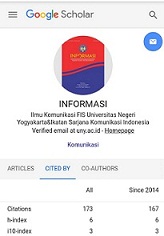Kartini in two lenses: The shifting image of Indonesian modern woman in R.A. Kartini (1982) and Kartini (2017)
DOI:
https://doi.org/10.21831/informasi.v53i2.61378Keywords:
Kartini, Javanese Woman, Image, Constructed FigureAbstract
References
Adawiyah, R., & Rachmaria, L. (2021). Mitos "Kanca Wingking" Perempuan Jawa dalam Film Kartini. PANTAREI, 5(02). https://jom.fikom.budiluhur.ac.id/index.php/Pantarei/article/view/746
Ade, R. N. A. T. (2020). Campur Kode Bahasa Indonesia pada Tuturan Berbahasa Jawa dalam Film Kartini Karya Hanung Bramantyo. Aksara: Jurnal Ilmiah Pendidikan Bahasa Dan Sastra Indonesia, 3(2), 133–140. https://doi.org/10.33087/AKSARA.V3I2.127
Amalia, L. S. (2010). Kiprah Perempuan di Ranah Politik dari Masa ke Masa – PUSAT RISET POLITIK. https://politik.brin.go.id/kolom/etnisitas-gender-agama/kiprah-perempuan-di-ranah-politik-dari-masa-ke-masa/
Asyraf, M. A., & H.A., S. H. (2020). Mode of The Domestication of Women in Indonesian Political System | Balairungpress. https://www.balairungpress.com/2020/04/mode-of-the-domestication-of-women-in-indonesian-political-system/
Bramantyo, H. (2017). Kartini. Legacy Pictures.
Chen, J. (2022). Millennials: Finances, Investing, and Retirement. https://www.investopedia.com/terms/m/millennial.asp
Chin, G. V. S. (2018). State Ibuism and One Happy Family: Polygamy and the "Good" Woman in Contemporary Indonesian Narratives. In G. V. S. Chin & K. Mohd Daud (Eds.), The Southeast Asian Woman Writes Back (pp. 89–106). Springer Singapore. https://doi.org/10.1007/978-981-10-7065-5_6
Ferber, M. (2007). A Dictionary of Literary Symbols Second Edition (2nd Ed). Cambridge University Press Cambridge.
Hasanah, A., & Witarti, D. I. (2018). Representasi Bakti Kartini pada Orang Tua dalam Film Kartini ( Analisis Semiotika atas Film Kartini ). PANTAREI, 4(2), 1–9.
IMDb. (2017). Kartini. IMDb. https://www.imdb.com/title/tt5882416/?ref_=nv_sr_srsg_0
IMDb. (2022). Raden Ajeng Kartini (1989). IMDb. https://www.imdb.com/title/tt0337076/
Kartini, R. A., & Coté, J. (2021). Kartini: The Complete Writings 1898-1904. Kartini. https://doi.org/10.26180/14429024
Maulida, J., & Rahmadiyanti, P. S. (2020). Budaya Patriarki dalam Film Kartini (2017) Karya Hanung Bramantyo. Kawruh: Journal of Language Education, Literature and Local Culture, 2(1). https://doi.org/10.32585/KAWRUH.V2I1.651
Missy, J. (2022). Habis Gelap Terbitlah Terang by Raden Adjeng Kartini. Goodreads. https://www.goodreads.com/book/show/4526775-habis-gelap-terbitlah-terang
Muchtar, U. (2020). 200 Tahun Multatuli, Penyadar Rakyat Indonesia. PT. Media Digital Historia. https://historia.id/politik/articles/200-tahun-multatuli-penyadar-rakyat-indonesia-DrL5Y/page/2
Putri, A., & Nurhajati, L. (2020). Representasi perempuan dalam kukungan tradisi Jawa pada film Kartini karya Hanung Bramantyo. ProTVF, 4(1), 42–63. https://doi.org/10.24198/PTVF.V4I1.24008
Sari, K. W., & Haryono, C. G. (2019). Hegemoni Budaya Patriarki pada Film (Analisis Naratif Tzvetan Todorov Terhadap Film Kartini 2017). SEMIOTIKA: Jurnal Komunikasi, 12(1). https://doi.org/10.30813/S:JK.V12I1.1542
Sarwoko, T. A. (2019). Representasi Kepahlawanan dalam Film Kartini 2017 (Studi Analisis Semiotika Model Charles Sanders Peirce). VISIONER, 1(1 April), 51–68. http://ojs.mputantular.ac.id/index.php/vis/article/view/179
Sjumandjaja. (1982). R.A. Kartini. PT Nusantara Herman Dial Harris Lasmana.
Taylor, J. G. (1989). Kartini in her historical context. Bijdragen Tot de Taal-, Land- En Volkenkunde / Journal of the Humanities and Social Sciences of Southeast Asia, 145(2), 295–307. https://doi.org/10.1163/22134379-90003256
Triana, D. R. (2019). Kesantunan Berbahasa pada Film Kartini Karya Hanung Bramantyo: Tinjauan Sosiopragmatik. HUMANIKA, 26(1), 14–23. https://doi.org/10.14710/HUMANIKA.V26I1.21995
Vale, M., & Lanhers, Y. (2022). St. Joan of Arc. Encyclopedia Britannica. https://www.britannica.com/biography/Saint-Joan-of-Arc
Wahid, A. (2021). Kartini's Views on Opium Problems in Java at the End of the 19th Century. Humaniora, 33(2), 113–125. https://doi.org/10.22146/JH.66466
Downloads
Published
How to Cite
Issue
Section
Citation Check
License
Authors who publish with this journal agree to the following terms:
- Authors retain copyright and grant the journal right of first publication with the work simultaneously licensed under a Creative Commons Attribution License that allows others to share the work with an acknowledgement of the work's authorship and initial publication in this journal.
- Authors are able to enter into separate, additional contractual arrangements for the non-exclusive distribution of the journal's published version of the work (e.g., post it to an institutional repository or publish it in a book), with an acknowledgement of its initial publication in this journal.
- Authors are permitted and encouraged to post their work online (e.g., in institutional repositories or on their website) prior to and during the submission process, as it can lead to productive exchanges, as well as earlier and greater citation of published work (See The Effect of Open Access).











